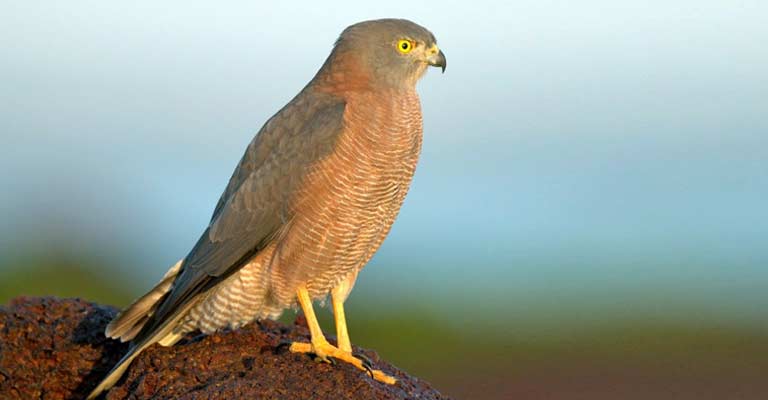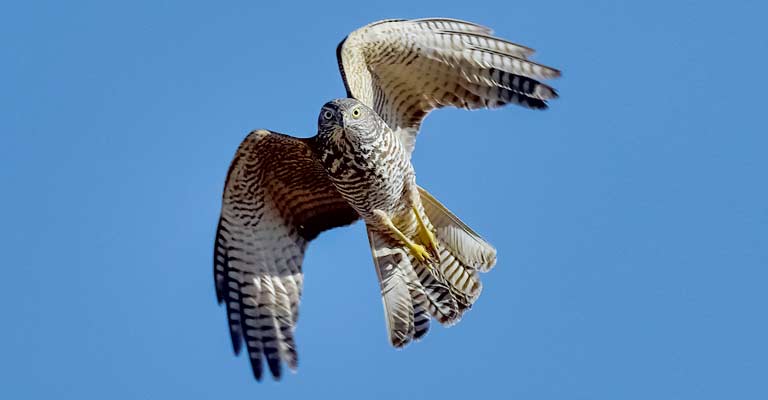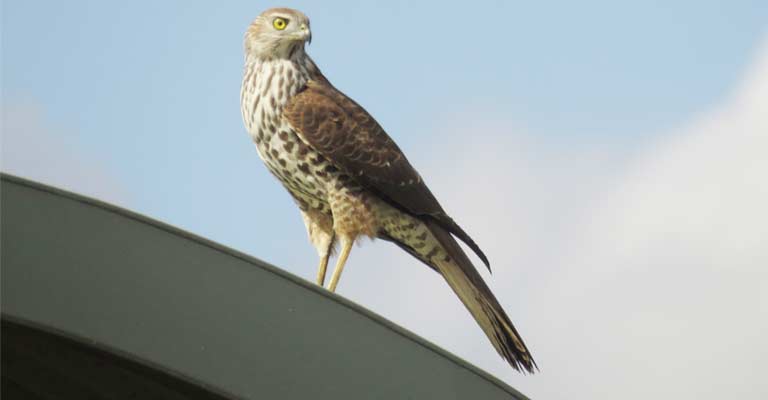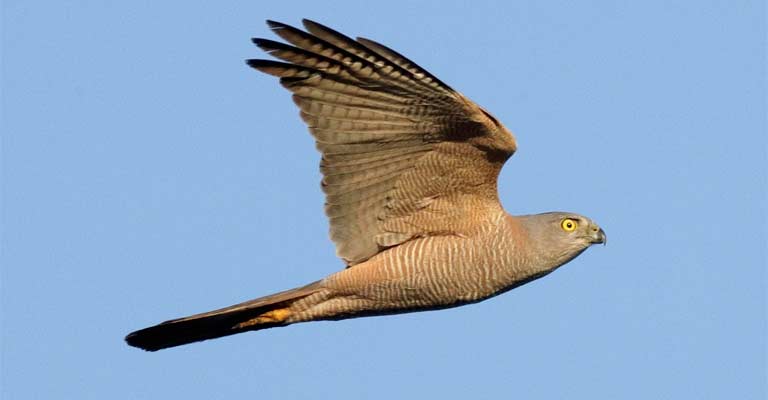The Brown Goshawk (Accipiter fasciatus) emerges as a captivating raptor within the avian realm, renowned for its impressive adaptability and distinctive features.
Belonging to the Accipitridae family, this bird of prey exhibits a widespread distribution across various habitats, from dense forests to urban areas, showcasing its remarkable versatility.
Characterized by a striking brown plumage adorned with intricate barring, the Brown Goshawk commands attention with its agile flight and sharp predatory instincts.
As a member of the Accipiter genus, this species plays a vital role in maintaining ecological balance by preying on a diverse range of small birds and mammals.
The Brown Goshawk’s ability to thrive in diverse environments and its prowess in hunting underscore its significance within the avian landscape, making it a subject of intrigue and admiration for bird enthusiasts and ornithologists alike.

Identifying Characteristics of Brown Goshawk
The Brown Goshawk (Accipiter fasciatus) is a distinctive raptor that exhibits unique characteristics, allowing bird enthusiasts and ornithologists to identify it with careful observation.
Here are eight key points to consider when identifying the Brown Goshawk:
Size and Shape

The Brown Goshawk is a medium-sized bird with a length ranging from 45 to 55 centimeters. Its robust build, short wings, and relatively long tail contribute to a distinctive silhouette. The size and shape distinguish it from other raptors in its range.
Plumage Coloration
The plumage of the Brown Goshawk varies between individuals, but it typically features shades of brown. Adults often showcase a dark brown upper body with a lighter, barred underbody. Juveniles may exhibit more mottled or streaked patterns.
Distinctive Head Markings
The head of the Brown Goshawk presents a distinctive look with a darker cap and a lighter eyebrow stripe or supercilium. This facial pattern enhances its overall appearance and aids in identification.
Eye Color

The striking yellow to orange eyes of the Brown Goshawk are a notable feature. The intensity of the eye color adds to its predatory allure and is a crucial identification characteristic, especially during close observations.
Tail Bars

The tail of the Brown Goshawk is marked with distinct bars. These bars are usually darker than the surrounding feathers and contribute to the bird’s overall intricate and visually appealing plumage.
Flight Pattern

Observing the flight pattern of the Brown Goshawk provides additional identification clues. These raptors are known for their agile and direct flight, often characterized by quick and powerful wing beats, especially when pursuing prey.
Distinctive Vocalizations
While not always easy to hear, the Brown Goshawk produces vocalizations that can assist in identification. These calls vary from high-pitched whistles to sharp, repetitive notes, often utilized during courtship or territorial displays.
The Brown Goshawk’s identification relies on a combination of size, plumage coloration, distinctive head markings, eye color, tail bars, flight pattern, habitat preferences, and vocalizations.
Acquiring a comprehensive understanding of these characteristics enhances the ability to recognize and appreciate the presence of this unique raptor in its varied habitats.
Taxonomy of Brown Goshawk

Here is a table outlining the taxonomical details of the Brown Goshawk (Accipiter fasciatus):
| Taxonomic Level | Classification |
| Domain | Eukaryota |
| Kingdom | Animalia |
| Phylum | Chordata |
| Class | Aves |
| Order | Accipitriformes |
| Family | Accipitridae |
| Genus | Accipiter |
| Species | A. fasciatus |
The Brown Goshawk (Accipiter fasciatus) is a bird of prey classified under the Animalia kingdom, Chordata phylum, Aves class, and Accipitriformes order.
It belongs to the Accipitridae family and the Accipiter genus. The species name, fasciatus, highlights its distinct banded or barred plumage.
With a medium size, ranging from 45 to 55 centimeters, and notable features such as a darker cap, barred underparts, and striking yellow-orange eyes, the Brown Goshawk is recognized for its adaptability across various habitats, including forests and urban areas.
This taxonomic classification provides a systematic understanding of its place in the avian hierarchy.
Brown Goshawk Life History
The life history of the Brown Goshawk (Accipiter fasciatus) unfolds as a captivating narrative within the avian realm, blending elements of adaptation, predation, and conservation challenges.
As a medium-sized raptor, the Brown Goshawk’s life history is a testament to its versatility and resilience across various landscapes.
Food

The Brown Goshawk’s dietary preferences center around a carnivorous appetite, predominantly targeting small birds and mammals.
With a keen eye and sharp talons, it adeptly captures prey during swift aerial pursuits, showcasing its prowess as a skilled hunter.
Habitat
Adaptable to diverse environments, the Brown Goshawk occupies a range of habitats, from dense forests to urban areas.
Its ability to thrive in various ecosystems underscores its flexible approach to nesting, hunting, and establishing territories.
Range Map
The Brown Goshawk boasts a widespread distribution across Australasia, including Australia, New Guinea, and nearby islands.
A comprehensive range map delineates its presence in a variety of geographical settings, emphasizing the need for conservation initiatives across its expansive habitat.
Nesting

Nesting behavior is meticulous, with the Brown Goshawk constructing platforms of sticks, usually situated in the canopy of tall trees.
The choice of concealed locations enhances protection for eggs and nestlings, highlighting an adaptation to reduce vulnerability to potential predators.
Here’s a table summarizing the nesting details of the Brown Goshawk (Accipiter fasciatus):
| Nesting Details | Facts |
| Clutch Size | Typically 2 to 4 eggs |
| Number of Broods | Usually 1 to 2 broods per breeding season |
| Egg Length | Approximately 4.5 to 5.5 centimeters |
| Egg Width | Around 3.5 to 4.0 centimeters |
| Incubation Period | Approximately 35 days |
| Nestling Period | About 4 to 5 weeks |
| Egg Description | Oval-shaped, with a pale background and irregular reddish-brown markings. |
| Nest Type | Constructed with sticks, usually in the canopy of tall trees. |
| Parental Involvement | Both males and females participate in the incubation and feeding of the nestlings. |
Breeding
The Brown Goshawk engages in monogamous breeding, forming strong pair bonds. Courtship displays involve aerial acrobatics and vocalizations, contributing to the establishment and reinforcement of pair bonds.
The female typically lays a clutch of eggs, and both parents actively participate in incubation and raising the offspring.
Diseases
While resilient, Brown Goshawks can be susceptible to various diseases, affecting their overall health and reproductive success. Monitoring for signs of illness is crucial for early intervention and conservation efforts.
Treatment
Treatment involves a multi-faceted approach, encompassing veterinary care, habitat preservation, and mitigating potential threats.
Collaborative efforts between wildlife experts, researchers, and conservationists are instrumental in ensuring the well-being of the Brown Goshawk population.
Conservation
Conservation initiatives play a pivotal role in securing the Brown Goshawk’s future.
Habitat preservation, monitoring breeding success, and raising awareness about the importance of these raptors in maintaining ecological balance contribute to safeguarding this adaptable and integral species within the avian landscape.
As urbanization continues to encroach upon natural habitats, proactive conservation measures become increasingly vital for the sustained existence of the Brown Goshawk.
10 Amazing Facts About Brown Goshawk
The Brown Goshawk (Accipiter fasciatus) is a remarkable bird of prey, showcasing a blend of adaptability, hunting prowess, and distinctive characteristics. Here are 10 amazing facts about the Brown Goshawk:
- Versatile Habitat: Brown Goshawks exhibit remarkable adaptability, thriving in various habitats, from dense forests and woodlands to urban areas. This versatility underscores their ability to coexist with human landscapes.
- Stealthy Predators: Renowned for their skilled hunting techniques, Brown Goshawks are adept at capturing prey in flight. Their agility, combined with sharp talons and keen vision, makes them efficient predators of small birds and mammals.
- Intricate Plumage: Adult Brown Goshawks display a striking combination of dark brown upperparts and barred underparts, while juveniles may exhibit more mottled patterns. The intricate plumage aids in camouflage within their diverse habitats.
- Monogamous Pairs: Brown Goshawks engage in monogamous breeding pairs, forming strong bonds. Courtship displays involve aerial acrobatics and vocalizations, contributing to the establishment and reinforcement of pair bonds.
- Urban Adaptation: Unlike many raptors, Brown Goshawks display an ability to adapt to urban environments. They can be found in parks and gardens, demonstrating a capacity to coexist with human settlements.
- Energetic Flight: Characterized by direct and powerful flight, Brown Goshawks navigate their habitats with agility. Their swift wing beats and aerial maneuvers contribute to their success as skilled hunters.
- Nest Construction: Nesting behavior involves the construction of sturdy platforms made from sticks. Nest sites are often situated in the canopy of tall trees, providing protection for eggs and nestlings.
- Vocal Displays: Brown Goshawks communicate through a range of vocalizations, including high-pitched whistles and sharp notes. These calls play a role in establishing territories and courtship displays.
- Egg Characteristics: The eggs of Brown Goshawks are oval-shaped with a pale background and irregular reddish-brown markings. The distinct appearance contributes to their identification during nesting observations.
- Conservation Concerns: Despite their adaptability, Brown Goshawks face conservation challenges due to habitat loss and potential threats. Conservation efforts are crucial to ensuring their continued existence and preserving their ecological role.
In essence, the Brown Goshawk’s amazing attributes, from its adaptability and hunting techniques to its urban presence and distinctive plumage, make it a species of both ecological significance and ornithological fascination.
Understanding and appreciating these facts contribute to the broader narrative of avian biodiversity.
Wrapping Up
The Brown Goshawk emerges as a captivating ambassador of adaptability and avian prowess within diverse landscapes.
From its versatile habitats to intricate plumage and skilled hunting techniques, this raptor stands as a testament to nature’s ingenuity.
The Brown Goshawk’s ability to navigate both natural and urban environments highlights its resilience and flexibility, fostering a coexistence with human activities.
As we unravel the layers of its life history, from monogamous pairings to the construction of resilient nests, a deeper appreciation for this bird of prey unfolds.
However, amidst the marvel, conservation concerns loom, urging us to address habitat loss and potential threats.
Preserving the Brown Goshawk’s ecological role becomes not only an imperative for the species but also a commitment to maintaining the delicate balance of biodiversity.
Ultimately, the Brown Goshawk invites us into the fascinating world of avian adaptation, encouraging a collective effort to safeguard its place in the intricate tapestry of our natural environment.